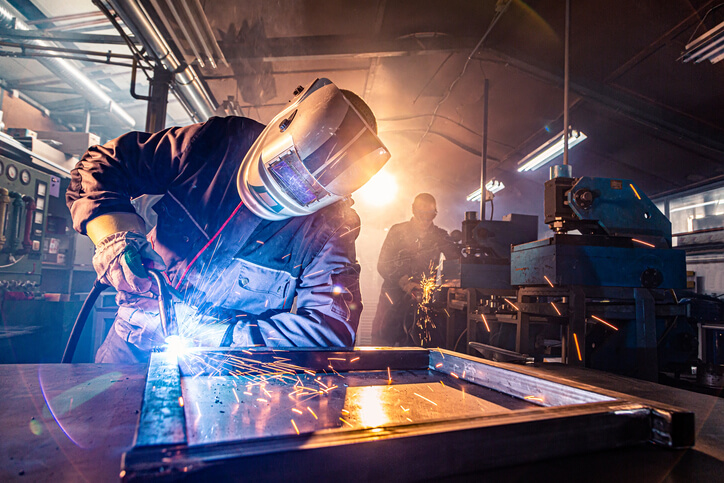Steel is a cornerstone of modern construction, valued for its strength, versatility, and cost-effectiveness. But before these beams and plates become the skeleton of a skyscraper or the frame of a bridge, they undergo a transformation process known as steel fabrication. This article delves into the world of steel fabrication & welding, exploring the techniques that turn raw steel into the building blocks of our infrastructure.

The Art of Steel Fabrication
Steel fabrication is the process of shaping, cutting, and assembling steel sections to create components for a construction project. This can be done either on-site or, more commonly, in a dedicated fabrication shop. Shop fabrication offers several advantages, including:
- Quality Control: A controlled environment allows for precise cutting, bending, and welding using specialized machinery, ensuring consistent quality and minimizing errors.
- Efficiency: Production line techniques streamline the process, reducing waste and overall project timelines.
- Safety: A dedicated shop prioritizes safety protocols, with proper ventilation, designated work areas, and readily available safety equipment.
The fabrication process itself involves several key steps:
- Design and Planning: Using engineering software, detailed plans are created, specifying the dimensions, shapes, and connection points for each steel component.
- Material Selection: The appropriate steel grade and thickness are chosen based on the structural requirements and desired properties.
- Cutting: Techniques like oxyfuel cutting, plasma cutting, or sawing are used to precisely cut the steel into the required shapes and sizes.
- Forming and Bending: によっては (yori ni yotte wa), (depending on the project), specific sections may require bending or shaping using presses, brakes, or rolling mills.
- Assembly and Welding: The prepped steel pieces are meticulously positioned and joined together using various welding techniques, creating the final structural elements.
- Quality Control: Rigorous inspections are conducted throughout the process to ensure welds meet strength and quality standards.
- Painting and Coating (Optional): For added protection against corrosion or aesthetic purposes, a protective coating may be applied.
The Magic of Welding
Welding is the glue that holds steel fabrication together. It's a process that uses intense heat to melt and fuse together two separate pieces of metal, creating a permanent bond. Here are some of the most common welding techniques used in steel construction:
- Shielded Metal Arc Welding (SMAW): Also known as stick welding, this versatile method uses a consumable electrode coated in flux to create a protective gas shield around the weld pool.
- Gas Metal Arc Welding (GMAW): Often referred to as MIG welding, this technique utilizes a continuously fed consumable wire electrode and an inert gas shield for clean and fast welding.
- Flux-Cored Arc Welding (FCAW): Similar to MIG welding, but the electrode core contains flux for additional shielding and alloying elements.
- Submerged Arc Welding (SAW): An automated process that uses a continuously fed consumable electrode and submerged granular flux to achieve high-quality, deep penetration welds.
The choice of welding technique depends on factors like the thickness of the steel, the desired weld properties, and the fabrication environment.
Beyond the Basics
Steel fabrication offers a remarkable degree of flexibility. With the right techniques, steel can be transformed into a vast array of shapes and components, including:
- Structural Beams and Columns: The backbone of a building's frame, these elements provide vertical and horizontal support.
- Trusses: Lightweight yet strong trusses are ideal for spanning large distances and creating open floor plans.
- Floor and Roof Decking: Steel sheets form the base for floors and roofs, providing a platform for further construction.
- Stairs and Railings: Steel offers a durable and customizable option for staircases and safety railings.
- Miscellaneous Steel: From wall bracing to custom brackets, steel fabrication can create a wide variety of additional building elements.
The Future of Steel Construction
Steel fabrication is constantly evolving, with advancements in technology and automation streamlining processes and improving efficiency. Here are some exciting trends to watch:
- Computer-Aided Design/Manufacturing (CAD/CAM): These tools allow for precise design and automated control of cutting and drilling machines, minimizing errors and waste.
- Robotics: The use of robots for repetitive tasks like welding can enhance consistency and safety in fabrication shops.
- Prefabricated Steel Construction: This method involves creating entire building sections in a controlled environment, leading to faster on-site assembly and reduced construction time.
Conclusion
Steel fabrication & welding are the essential skills that breathe life into steel. Through careful planning, precise techniques, and skilled craftsmanship, these processes transform raw steel into the building blocks

No comments yet